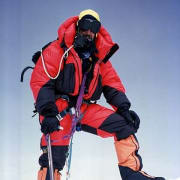The World's Toughest Ultramarathons: From Everest to the Sahara Desert

Extreme Ultramarathons
Ultra runners possess characteristics that most human beings can't comprehend. Grueling distance events require extreme mental and physical discipline and conditioning by those that dare participate. Runners face dramatic changes in elevation, debilitating heat, fuel and hydration issues, and very long distances when competing in the toughest Ultra’s. Competitors in this rarified world actually learn to embrace the pain, and convert the agony into fuel. One of these races, the Badwater 135, is currently underway in Death Valley where temperatures will exceed 120°F. To celebrate the running of the Badwater 135, I had a look at other brutal tests of endurance – from Mt. Everest to the Sahara desert.
The Ultra Trail du Mont Blanc
The Ultra-Trail du Mont Blanc , “UTMB”, is one of the most prestigious and challenging trail running races in the world. This mountainous and grueling test is held in August each year, and begins in Chamonix, France. The UTMB is staged on a 106-mile loop around the Mont Blanc Massif. The race reaches 10,000 ft. of vertical feet several times with a total race elevation gain of over 32,800 ft. Competitors run through three different countries: France, Italy, and Switzerland.
Hardrock 100-Mile Endurance Run
The Hardrock 100-Mile Endurance Run is held annually in Silverton, Colorado in the San Juan Mountains in July. It is one of the most challenging and revered ultramarathons in the world and, perhaps, better suited for mountaineers than ultra runners. This grueling race covers 100.5 miles with huge elevation gains totaling approximately 33,000 ft., and reaches an altitude of 14,048 ft. at the summit of Handies Peak. The race's time limit is 48-hours. Race finishers are obligated to kiss the notorious ‘Hardrock’ at the finish line.
Spartathon
The Spartathlon is a historic ultramarathon that traces the legendary route of Pheidippides, the ancient Athenian messenger. It is held in Greece each year, covering 153 miles from Athens to Sparta, and has strict time limits. Competitors start at the Acropolis in Athens and run through diverse terrains, including paved roads, muddy mountain trails, and coastal paths. The race features significant elevation changes, with an epic climb at night up 4,000 ft. Mount Parthenio.
Mt. Everest Marathon
The Everest Marathon is the highest race in the world. It starts at Mt. Everest Base Camp, 17,598 ft., and ends in Namche Bazaar at 11,286 ft. This race is held on May 29th each year to commemorate the first successful ascent of Mt. Everest by Sir Edmund Hillary and Tenzing Norgay in 1953. The 26.2-mile marathon course descends through the rugged Khumbu Valley, passing through ancient villages and rhododendron forests, and over suspension bridges. Despite the downhill course, the rough terrain and thin air make this a very difficult race. Participants must undergo a mandatory three-week trek to acclimatize before the race starts.
Badwater 135
The Badwater 135 is another one of the toughest ultramarathons in the world, covering 135 miles from Death Valley to Mount Whitney in California. It is held in July, and takes place in extreme heat, with temperatures often exceeding 120°F. The race starts at Badwater Basin, the lowest point in North America, and climbs 14,600 ft. to the trailhead of Mount Whitney, the highest peak in the contiguous United States. Runners face three significant mountain ascents. (Harvey Lewis, first from Left at the Badwater 135, 2024.)
Marathon des Sables
The Marathon des Sables (MdS) is a legendary ultramarathon held over six days each spring in the middle of the scorching Sahara Desert of Morocco. Competitors cover approximately 155 miles in one of the world's harshest environments. Participants traverse vast sand dunes and face extreme heat, with daytime temperatures often exceeding 120°F. The race is self-sufficient, requiring runners to carry their food and gear while water is rationed and provided at checkpoints. The race’s founder, Patrick Bauer, walked 217 miles, self-supported, through the Sahara, and created the race in 1986.
